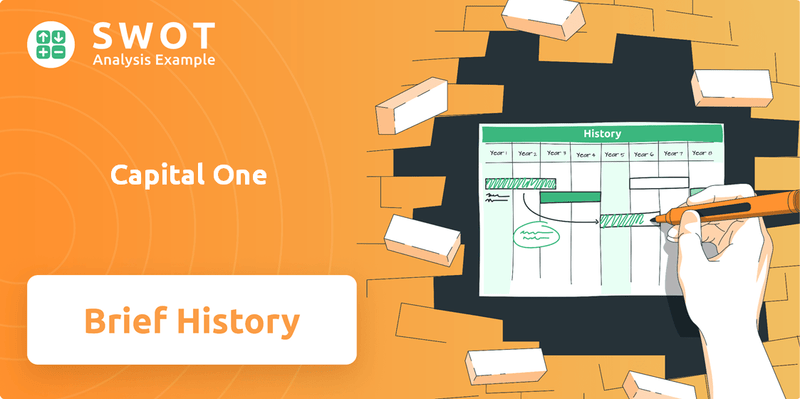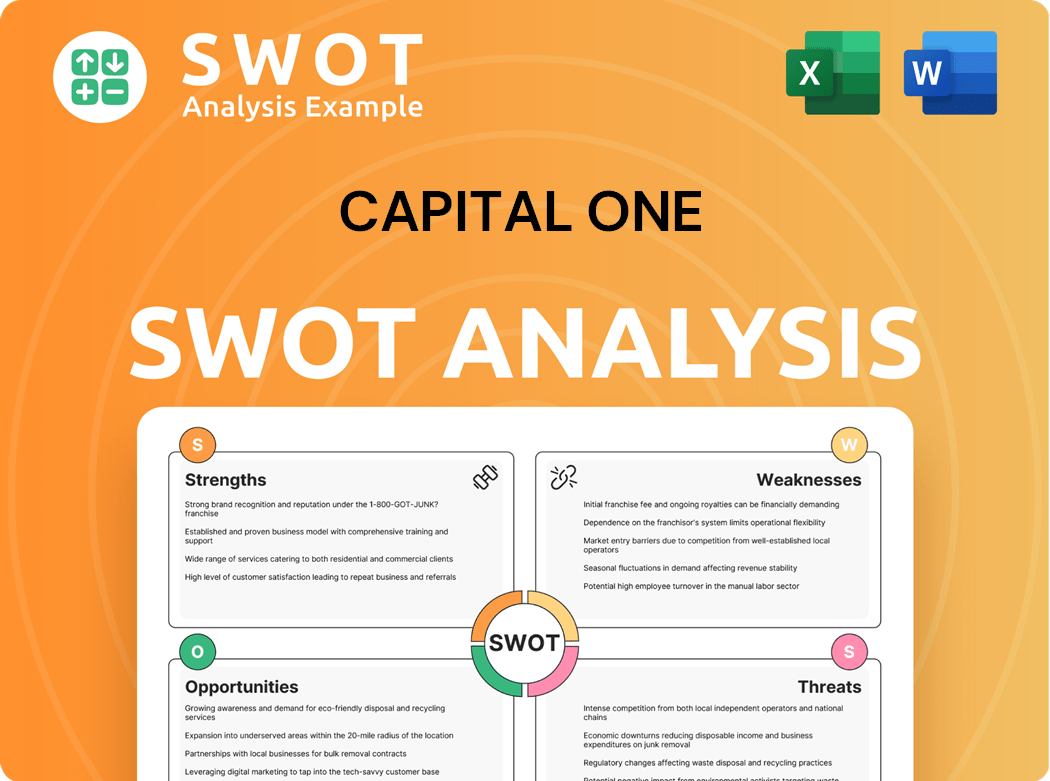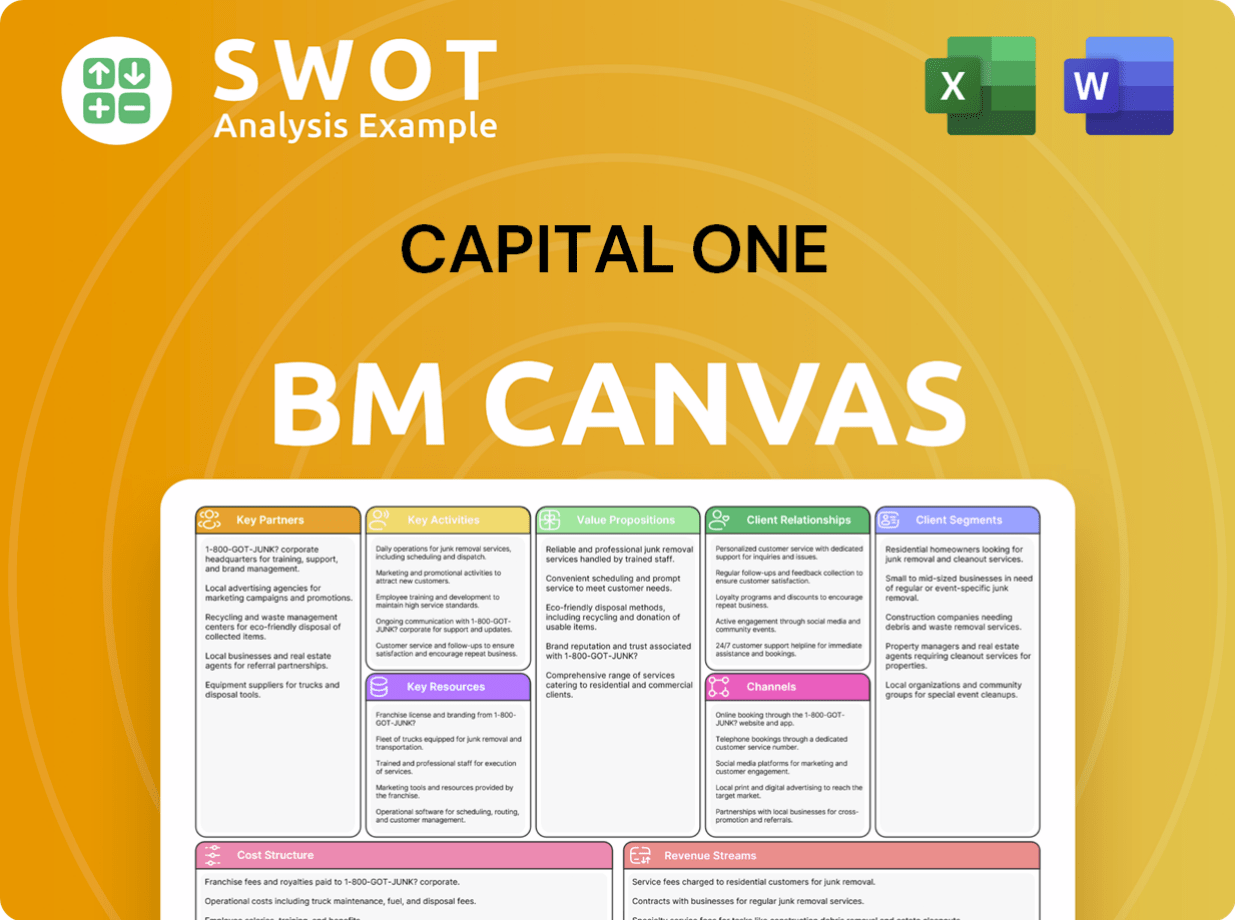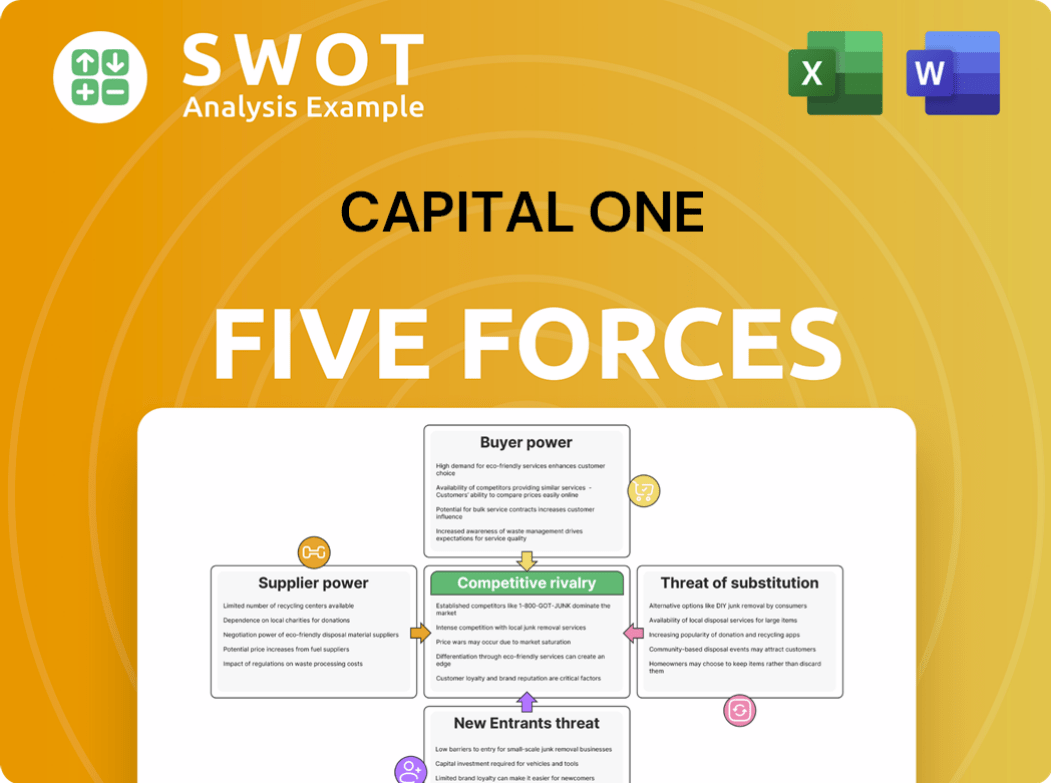Capital One Bundle
How did Capital One revolutionize the financial world?
Capital One's story is a compelling narrative of data-driven disruption in the financial services sector. From its unconventional beginnings, the company challenged traditional banking norms, leveraging sophisticated analytics to redefine credit card marketing. This innovative approach propelled Capital One to the forefront of the industry, marking a significant shift in how financial products were designed and delivered.

Founded in 1994, the Capital One SWOT Analysis reveals the company's strategic evolution, from a specialized credit card issuer to a diversified financial powerhouse. Understanding the Capital One timeline and Capital One history is crucial to grasping its impact on the financial landscape. This article delves into the Capital One company, exploring its key milestones, strategic decisions, and the challenges it overcame to become a major player in Capital One financial services, including its Capital One credit cards and strategic Capital One acquisitions.
What is the Capital One Founding Story?
The story of the Capital One company begins with its official spin-off from Signet Financial Corp. on February 28, 1995. However, the groundwork for this financial powerhouse was laid earlier within Signet Bank. This innovative approach to credit cards would soon revolutionize the industry.
Co-founded by Richard Fairbank and Nigel Morris, the company was built on a foundation of data analysis and a 'test and learn' methodology. Fairbank, with a background in consulting at McKinsey & Company, joined Signet Bank in 1987. Morris, also from McKinsey, joined Fairbank at Signet. They saw an opportunity to move beyond the traditional, one-size-fits-all approach to credit cards.
Their vision was to use data to understand customer behavior and offer tailored products. This involved experimenting with interest rates, credit limits, and features to find what worked best for different customer segments, essentially creating a 'mass customization' model for credit cards. Initial funding came from Signet Bank before the spin-off. The founders' belief in the power of information set the stage for a new kind of financial institution, shaping the Capital One history.
The early days of Capital One were marked by an intense focus on data and analytics, which was embedded in the company's culture from the start. This data-driven approach allowed for the creation of dynamically priced and structured credit cards.
- The initial product was a credit card with pricing based on sophisticated underwriting models.
- Fairbank and Morris's expertise in analytical rigor was key to their success.
- The economic context of the early 1990s, with increasing consumer credit, provided fertile ground for their model.
- Their approach contrasted sharply with the less sophisticated risk management practices of the time.
The founders' strategy was to segment the market and offer customized credit card products. This involved rigorous testing of different financial terms to identify what resonated with specific customer segments. The company's ability to adapt and innovate quickly was a key factor in its early success. The founders' vision and the company's initial focus on data analysis set the stage for its future growth and expansion in the financial sector. For more insights into the company's ownership structure, you can read about the Owners & Shareholders of Capital One.
Capital One SWOT Analysis
- Complete SWOT Breakdown
- Fully Customizable
- Editable in Excel & Word
- Professional Formatting
- Investor-Ready Format

What Drove the Early Growth of Capital One?
Following its spin-off in 1995, the Capital One company embarked on a period of rapid expansion. This growth was fueled by a data-driven approach to the credit card market, focusing on segmented offerings and direct marketing. The company quickly amassed a substantial customer base, establishing itself as a significant player in the financial services industry.
Early product launches focused on highly segmented credit card offerings. These included balance transfer cards, rewards cards, and subprime offerings. Each product was meticulously tested and refined based on performance data, allowing for precise targeting and offer optimization. The company's strategy was to cater to diverse customer segments with tailored financial products.
Direct mail marketing was the primary method for customer acquisition. By 1997, the company had already acquired over 5 million accounts. This rapid growth demonstrated the effectiveness of its targeted marketing strategies and its ability to quickly gain market share. This early success set the stage for further expansion and diversification.
The company significantly expanded its team, particularly in areas like statistics, analysis, and technology. Headquarters remained in McLean, Virginia, but operational infrastructure grew to include call centers and processing facilities. This expansion was crucial to supporting the increasing customer base and managing the growing volume of transactions.
In 1998, the company entered the United Kingdom credit card market, marking its first international expansion. This demonstrated the scalability of its data-driven approach beyond the US market. In 2001, the acquisition of PeopleFirst Inc. signaled its entry into the auto finance market. For more details on its financial strategies, see Revenue Streams & Business Model of Capital One.
Capital One PESTLE Analysis
- Covers All 6 PESTLE Categories
- No Research Needed – Save Hours of Work
- Built by Experts, Trusted by Consultants
- Instant Download, Ready to Use
- 100% Editable, Fully Customizable

What are the key Milestones in Capital One history?
The Capital One company has a rich Capital One history, marked by strategic moves and significant growth. From its early days to its current status as a major player in Capital One financial services, the company has achieved several key milestones. The Capital One timeline showcases its evolution and adaptation to the ever-changing financial landscape.
| Year | Milestone |
|---|---|
| 1994 | Founded as a subsidiary of Signet Financial, focusing on Capital One credit cards. |
| 1995 | Launched its first credit card products, quickly gaining market share through innovative marketing and risk management strategies. |
| 2001 | Acquired PeopleFirst Inc., marking its entry into the auto finance market. |
| 2006 | Acquired North Fork Bancorporation for approximately $13.2 billion, expanding into retail banking. |
| 2009 | Acquired Chevy Chase Bank, further growing its deposit base and physical banking presence. |
| 2019 | Announced a significant data breach affecting over 100 million customers, leading to increased cybersecurity investments. |
| 2020 | Completed the transition to a cloud-first infrastructure, becoming the first major U.S. bank to go all-in on the public cloud. |
Capital One has consistently embraced innovation throughout its history, particularly in data analytics and technology. Its early adoption of 'test and learn' strategies revolutionized the credit card industry, enabling rapid product development and pricing adjustments.
Capital One pioneered the use of statistical modeling to understand customer behavior and risk, which was a groundbreaking approach in the credit card industry.
The company fostered a culture of experimentation, allowing for the rapid development and deployment of new products and pricing strategies, which is a key factor in its growth.
Embracing cloud computing and becoming a technology-first financial institution, including shutting down traditional data centers and moving to the public cloud, set a new standard in the industry.
Capital One has been at the forefront of using data to personalize marketing campaigns, offering tailored products and services to different customer segments.
The company has invested heavily in its mobile banking platform, providing customers with convenient and secure access to their accounts and financial services.
Capital One has integrated AI and machine learning into various aspects of its operations, from fraud detection to customer service, improving efficiency and customer experience.
Despite its successes, Capital One has faced several challenges, including economic downturns and data security breaches. The company's ability to adapt and learn from these experiences has been crucial to its resilience.
The 2008 financial crisis significantly impacted consumer credit, leading to increased loan defaults and requiring Capital One to tighten lending standards and focus on risk management.
The financial services industry is highly competitive, with other institutions constantly trying to replicate Capital One's data-driven approach and innovative strategies.
The 2019 data breach, which compromised the personal information of over 100 million customers, led to significant reputational damage and regulatory scrutiny, prompting substantial investments in cybersecurity enhancements.
As a major financial institution, Capital One faces ongoing regulatory scrutiny, requiring compliance with complex and evolving financial regulations, which can be a significant operational challenge.
The 'test and learn' culture inherently involves product failures, where some experiments do not yield the desired results, requiring continuous evaluation and adaptation of strategies.
Adapting to market shifts and technological advancements, such as the rise of fintech and evolving customer preferences, requires Capital One to continuously innovate and transform its business model.
For more insights into the company's target market, consider exploring the Target Market of Capital One.
Capital One Business Model Canvas
- Complete 9-Block Business Model Canvas
- Effortlessly Communicate Your Business Strategy
- Investor-Ready BMC Format
- 100% Editable and Customizable
- Clear and Structured Layout

What is the Timeline of Key Events for Capital One?
The story of the [Company Name] is marked by strategic moves and technological innovation. From its inception as a spin-off to its current position as a major financial player, the company has consistently adapted to the changing financial landscape. Its journey includes key acquisitions and a significant shift towards digital transformation, shaping its impact on the credit card and banking sectors. The company's commitment to using data and technology to offer financial products has been a constant throughout its history, making it a notable entity in the financial world.
| Year | Key Event |
|---|---|
| 1994 | [Company Name] is founded as a spin-off from Signet Financial Corp. |
| 1995 | [Company Name] officially becomes an independent company. |
| 1998 | Expands internationally, entering the United Kingdom credit card market. |
| 2001 | Acquires PeopleFirst Inc., entering the auto finance market. |
| 2006 | Acquires North Fork Bancorporation, significantly expanding its banking operations. |
| 2009 | Acquires Chevy Chase Bank, further strengthening its retail banking presence. |
| 2012 | Acquires ING Direct USA, significantly boosting its online banking presence and deposit base. |
| 2019 | Experiences a major data breach, leading to increased focus on cybersecurity. |
| 2020 | Becomes the first major U.S. bank to move all its technology infrastructure to the public cloud. |
| 2024 | Announces agreement to acquire Discover Financial Services in an all-stock transaction valued at approximately $35.3 billion. |
The planned acquisition of Discover Financial Services, announced in February 2024, is a major strategic move. This acquisition, valued at around $35.3 billion, aims to create a strong payments presence. This expansion is expected to boost the company's competitiveness in the credit card and payments industry, significantly impacting its market share and future growth. This is a key element of the company’s growth strategy.
The company is heavily invested in digital transformation, using AI and machine learning. This focus aims to improve customer experiences, personalize offerings, and enhance risk management. The "all-in" cloud strategy continues to drive innovation and operational efficiency. These technological advancements are essential for staying competitive in the evolving financial sector.
The company's future is influenced by the rise of digital payments and fintech competitors. Customer expectations for seamless digital experiences are also key factors. Analyst predictions suggest the Discover acquisition could lead to significant market share gains. The company's current market position reflects its ability to adapt and leverage technology in the financial sector.
Leadership emphasizes responsible innovation and a customer-centric approach. The company's founding vision of using information and technology to provide financial products remains central. The strategy focuses on digital leadership and scale. This approach is expected to shape the company's direction in the coming years.
Capital One Porter's Five Forces Analysis
- Covers All 5 Competitive Forces in Detail
- Structured for Consultants, Students, and Founders
- 100% Editable in Microsoft Word & Excel
- Instant Digital Download – Use Immediately
- Compatible with Mac & PC – Fully Unlocked

Related Blogs
- What is Competitive Landscape of Capital One Company?
- What is Growth Strategy and Future Prospects of Capital One Company?
- How Does Capital One Company Work?
- What is Sales and Marketing Strategy of Capital One Company?
- What is Brief History of Capital One Company?
- Who Owns Capital One Company?
- What is Customer Demographics and Target Market of Capital One Company?
Disclaimer
All information, articles, and product details provided on this website are for general informational and educational purposes only. We do not claim any ownership over, nor do we intend to infringe upon, any trademarks, copyrights, logos, brand names, or other intellectual property mentioned or depicted on this site. Such intellectual property remains the property of its respective owners, and any references here are made solely for identification or informational purposes, without implying any affiliation, endorsement, or partnership.
We make no representations or warranties, express or implied, regarding the accuracy, completeness, or suitability of any content or products presented. Nothing on this website should be construed as legal, tax, investment, financial, medical, or other professional advice. In addition, no part of this site—including articles or product references—constitutes a solicitation, recommendation, endorsement, advertisement, or offer to buy or sell any securities, franchises, or other financial instruments, particularly in jurisdictions where such activity would be unlawful.
All content is of a general nature and may not address the specific circumstances of any individual or entity. It is not a substitute for professional advice or services. Any actions you take based on the information provided here are strictly at your own risk. You accept full responsibility for any decisions or outcomes arising from your use of this website and agree to release us from any liability in connection with your use of, or reliance upon, the content or products found herein.